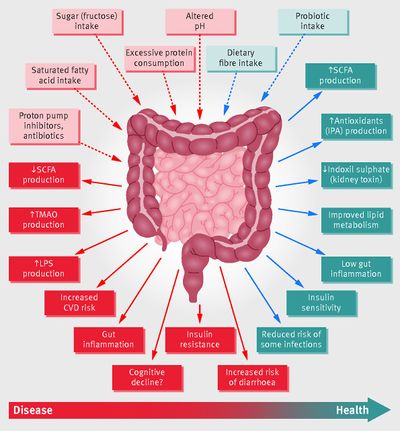The Human Gut
Overview
By Mia Tran
The human gut, also known as the gastrointestinal (GI) tract, consisting of all the organs that allow for humans to consume, digest, and expel food, and is highly populated by a diverse range of microbiota that serves many crucial processes in maintaining human health, such as digestion, fighting infection, and production of key vitamins and antioxidants. The microbes occupying the gut ranges to the order of 1017 and consists primarily of bacteria, but also includes a variety of protozoa, archaea, prokaryotes, and viruses.
Detailed Environmental Description
The physical environment of the GI tract consists of an interface ranging from 250-400 square meters in an adult human. The distribution of microbiota within this interface depends greatly on various gradients existing in the gut, such as nutrient and chemical gradients. Microbes tend to sit either in the lumen or mucosa, and very rarely penetrates the bowel wall, as most microbes that achieve this tend to be pathogenic.
The biogeochemical landscape of the gut various from organ to organ. The small intestine, the first organ in the tract following the stomach, is characterized by low pH, high oxygen, and an abundance of antimicrobials. These conditions allow for limiting microbe growth, just so facultative anaerobes begin to settle to the mucus lining of the intestine, making way for an environment conducive for obligate anaerobes. In the colon, or large intestine, there is a much more densely populated and diverse microbiota. Communities of bacteroides, streptococci, and clostridia can outnumber facultative anaerobes up to a ratio of 1000:1.
The study of microflora in the human gut began in 1970s, where a lot of initial research began with studying the composition and count of microbes. At the time, most of the work being done focused on strains that could be cultured. Since then, research exploded during the 2000s and 2010s due to the development of sequencing technologies that allowed scientists to learn about communities that could not be cultured in the lab.
Overview of Microbial Ecology as it is known
(To be added). Discuss the alpha and beta diversity of the system. Include some current research, with at least one figure showing data.
Acquisition of the Gut Microbiome at Birth and Infancy
Factors Changing the Composition of Gut Microbiota During Adulthood
Dysbiosis: Health Impacts of Disrupted Microflora
Key Microbial Players
In all of your systems there will be at least a couple of key microbial players. Describe these in detail. Where do they fall on the tree of life? Are they cultured? What do they do in general and as it relates to your target environment?
Conclusion
References
Authored for Earth 373 Microbial Ecology, taught by Magdalena Osburn, 2020, NU Earth Page.

